Great hall facts for kids
A great hall was the most important and largest room in a royal palace, a nobleman's castle, or a big manor house during the Middle Ages. Back then, the word great simply meant big. These huge rooms were common in countries like England, France, Scotland, and other parts of Europe. They were the main gathering place for everyone living in the building.
Contents
What Did a Great Hall Look Like?
A great hall was usually shaped like a rectangle. It was often one and a half to three times longer than it was wide. These halls were also very tall, often higher than they were wide, giving them a very open and grand feeling. Imagine a room so big that many people could gather, eat, and even sleep there! At night, some people who worked or lived in the house might have slept right on the floor of the great hall.
Life in the Great Hall
The great hall was the center of daily life. It was where the lord or lady of the house would eat their meals with their family, guests, and servants. Important meetings and celebrations also took place here. It was a busy, lively space where everyone from the highest-ranking noble to the lowest servant might spend time.
Famous Great Halls You Can Still See
Many great halls from the past still exist today, showing us how impressive they were. Two very large royal halls are Westminster Hall in London, England, and the Wenceslas Hall inside Prague Castle in the Czech Republic.
Penshurst Place in Kent, England, has a great hall that was built in the 14th century. You can also find many great halls from the 16th century and early 17th century across England, Wales, and Scotland. Some examples include:
- Longleat (England)
- Burghley House (England)
- Bodysgallen Hall (Wales)
- Muchalls Castle (Scotland)
- Crathes Castle (Scotland)
However, by the late 1700s, the way people lived started to change. Homes became more private, with many smaller rooms for different activities. Because of this, the great hall slowly began to lose its main purpose.
Images for kids
-
The Great Hall in Barley Hall, York, restored to look like it did around 1483.
-
The Great Hall at Stokesay Castle.
-
The Great Hall at Stirling Castle, built for James IV. The large windows lit the high table.
-
The mid-14th century Great Hall at Penshurst Place, looking towards the Screens Passage with its two large doorways.
-
The classic medieval layout of three doorways to service rooms at the Old Rectory, Warton. These were originally hidden by a wooden screen.
-
The Great Hall of Stirling Castle, Scotland, showing the screens passage and the minstrels' gallery above.










